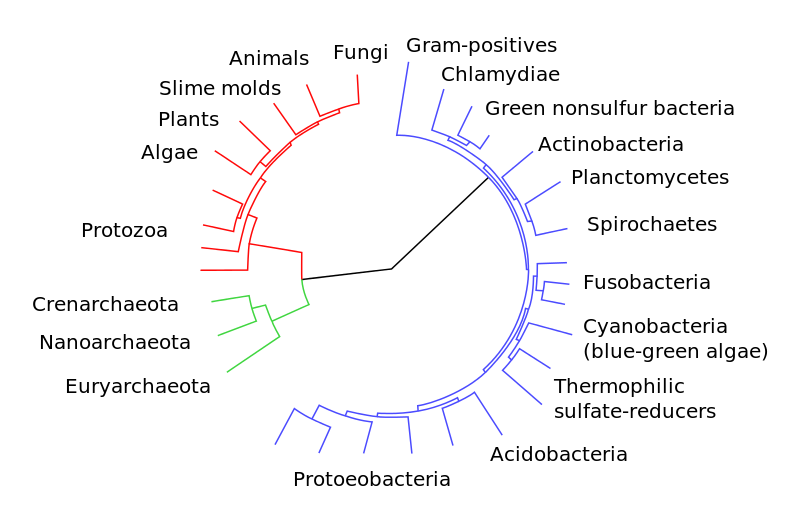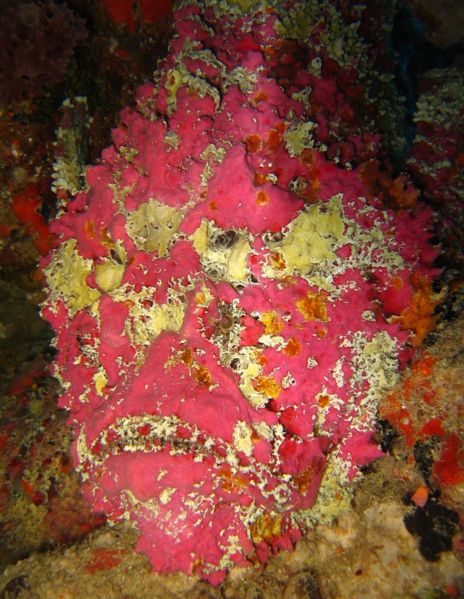What is it?
The Synanceia verrucosa in general terms is a fish. However, this fish can be broken down into seven basic taxonomic classifications and a few more sub-classes to be more specific and to define what exact fish this is. This is done using the Hierarchical System of Organism Classification that was created by the scientist Carolus Linneaus; which breaks down the organism’s characteristics into separate taxa/phylogenies. It begins with the domain of the organism and then becomes increasingly more specific. The domain of any organism can only be Bacteria, Archaea, or Eukarya. An interesting thing to be aware of is that viruses do not fall under any of these categories because they are not considered living. This is shown in an example of the human rhinovirus. The first level of the official system is labeled Kingdom; which is then followed by Phylum, Class, Order, Family, Genus, and species. Below is a picture demonstrating the three major domains of life in a tree. The red color is the Eukarya, and the stonefish fall under the Animal branch.
Classification of Synanceia verrucosa
Domain: Eukarya
Classified based on the presence of a nuclear envelope, membrane-bound organelles, introns in genes, and histones associated with DNA.
Super-group: Opisthokonta
This group is majorly defined by its DNA and rear flagella. Another super-group in Eukarya includes the group Excavata; which is characterized by its DNA, excavated groove, and odd flagella. Archaeplastida is another super-group, and is defined by its engulfed cyanobacteria. Land plants such as the Eastern white pine tree and the opium poppy belong under this group.
Kingdom: Animalia
The Kingdom Animalia is specifically known for being multicellular heterotrophs and having tissues that develop from embryonic layers. Animals include a wide range of species from insects like the mud dauber wasp or the death watch beetle to fully cephalized animals like the painted turtle, the Red-tailed hawk or the North American beaver. A common misconception is that snails such as the ramshorn snail or the North American terrestrial land snail are specifically insects, but they are in fact in a mollusk group characterized by features that are all their own.
Phylum: Chordata
Chordates share some very unique characteristics with other phyla in their Kingdom such as bilateral symmetry, being triploblastic, and having a coelom and a complete digestive tract. They do, however, have five characteristics that really set them apart from the rest. Chordates have a notochord, a dorsal tubular nerve chord, pharyngeal pouches (gills), an endostyle (thyroid gland), and a post anal tail all at some point in their development or throughout their lives. Some examples of members of the Chordate phyla are the American toad, the mute swan, and the thirteen-lined ground squirrel.
Subphylum: Craniata
This subphylum includes more of the “famously known” chordates such as birds, reptiles, and mammals because they are the organisms that have true cephalization and actual backbones. Thus, in simple terms, the Craniata are true vertebrates.
Class: Actinopterygii
This Class specifically includes fish and is commonly known as the ray-finned fish class. The Synanceia verrucosa has ray-fins all along its dorsal surface. To find more about the functions of these fins visit the interactions page.
Order: Scorpaeniformes
The distinguishing feature of the Scleroparei is their essentially backwards cheek-bone called the suborbital stay. This bone gives the group’s nickname as “mail-cheeked”. In appearance it is the bone located just below the eye-socket.
Family: Synanceiidae
This Family is specifically the stonefish family. There are about twenty specific species of stonefish and they all have similar features that link them to this family. Stonefish have small eyes and large oblique mouths. They also have short thick bodies and smooth skin that is covered with wart-like bumps in appearance. They also have similar ways of hunting their prey; which is discussed more in depth in the nutrition page.
The Synanceia genus includes the particularly venomous species of the stonefish. For more about the venom of the Synanceia verrucosa, visit the adaptations page.
Species: verrucosa
The Synanceia verrucosa in particular is the most venomous stonefish species in the world, it is popularly known as the reef stonefish.
The name Synanceia verrucosa from Latin to English translates to stonefish (Synanceia) of warts (verruca). The outer surface of the fish is covered with wart-like bumps; which is where the common name, stonefish, came from. Other common names for the stonefish are dornorn, reef stonefish, and poison scorpionfish. Continue on to learn more about the habitat of Synanceia verrucosa.
Back to home.

